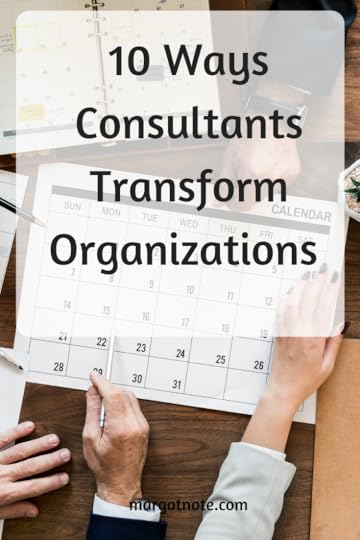Margot Note's Blog, page 34
July 1, 2019
Characteristics of Effective Archival Project Managers
Project managers for archival projects have a wide variety of responsibilities. They oversee activities, serve as liaisons between departments, and facilitate meetings. They hire staff, attend professional development activities, and review instructional materials. This post covers characteristics of effective archival project managers.
Project managers also fulfill several human resources type responsibilities during an archival project. These functions include negotiating with resource managers, assigning tasks, developing job descriptions, identifying training needs, and producing a team roster.
Working vs. ManagingOne of the biggest challenges archivists face is being a working project manager, or one who performs work while managing the project. In archival repositories, where staffing and funding can be limited, both managing and working on a project may be unavoidable. A project manager can perform work in a small team, but as the team size increases, working and managing simultaneously becomes impossible. When a conflict between the two arises, performing duties takes priority, and management is neglected.
Additionally, working project managers often choose the best tasks for themselves, which gives them a feeling of accomplishment since it’s easier to tell when a task is done than if a management initiative is finished. The fallacy of this approach is twofold. First, a detailed assignment might take time away from project management responsibilities. Secondly, by taking the interesting jobs for themselves, working project managers deprive others of meaningful work, decrease their motivation, and send signals that they mistrust their team.
Leading and ManagingEffective archival project managers need traditional management skills such as keeping people motivated, mediating between layers of the organizational hierarchy, making decisions, and allocating resources to their highest uses. The project manager must also control the schedule, budget, and quality standards. He or she must give attention to team-based issues such as interpersonal conflict, collaboration, and communication.
Archival project managers should be adept at steering the performance of their contributors while negotiating for resources and communicating their status and priorities to upper management. They must pay attention to project needs to make decisions, solve problems, and promote opportunities.
Trust, But VerifyMost project managers will become accustomed to dealing with information that is incomplete, optimistic, or inaccurate. Primarily, they should be savvy. Effective archival project managers check the information that they receive by knowing what questions to ask to prove validity. As they gain experience in a particular organization, they become capable of accessing people’s reliability so they can confirm the accuracy and completeness of information supplied. Good project managers learn to read people and listen to what they say—and don’t say—throughout a project.
Selecting Effective Archival Project ManagersThe choice of a project manager for an archival project should be deliberate. A project manager is granted the authority to manage across several organizational lines. Project management won’t succeed without effective project managers. Thus, if executive management approves a project for implementation, it should ensure that a qualified person is selected as the project’s manager. A project manager is more likely to gain the support of the team to meet goals if it’s clear that he or she has been selected by the organization’s executive management.
Not everyone makes a good project manager, however. The better ones are well organized and willing to do whatever it takes to keep their archival projects on time and budget. Charisma is the difference between competent and exceptional project managers. It takes charm to motivate people to deliver their best work under challenging circumstances.
The project manager also interacts with the rest of the organization on behalf of the team. The project manager should be politically aware and have excellent negotiation skills to commit stakeholders who are resistant to the project. The project manager must maintain resilience as problems and setbacks arise throughout the project too.
The Authority to SucceedAt some time during a project, something will go wrong, or a change will be requested that may risk the project missing its time and cost targets. For this reason, archival organizations should give project managers the authority within specific parameters to carry out their jobs without having to seek approval for changes to costs or deadlines. Agreeing to manage by exception removes the confusion of who may take charge when problems arise. Having some authority allows the archival project to move more easily into its successful conclusion.
The blog was originally published on Lucidea's blog.
If you like archives, memory, and legacy as much as I do, you might consider signing up for my email list. Every few weeks I send out a newsletter with new articles and exclusive content for readers. It’s basically my way of keeping in touch with you and letting you know what’s going on. Your information is protected and I never spam.
Follow me on Pinterest | Instagram | Twitter | LinkedIn | Facebook
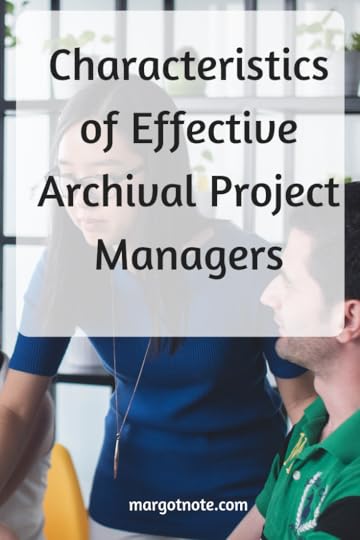
June 24, 2019
Writing a Digital Preservation Policy
Most archives repositories find it a challenge to keep a balance between meeting the needs of their users, their administration, and their collections. The hands-on tasks involved in the daily management of ever-growing collections of digital information leaves little time for conceptual planning of the digital preservation program.
However, institutions need to approach digital preservation holistically, rather than as a series of actions that fulfill the foundational requirements of stability and accessibility. Not only should institutions commit to creating and implementing digital preservation policies, but they need to understand that these actions are part of digital preservation in and of itself.
Why Digital Preservation Policy?Much in the same way that policies drive physical archival collections, so too should digital preservation policies for effective digital preservation. Clear policies state the principles, values, and intentions of the digital preservation activities of an institution. The policy also notes how it is monitored, who is responsible, and when and how it is updated. It can withstand organizational transitions and staff changes.
A digital preservation policy indicates, both internally and externally, that the institution values digital preservation and states its commitment to digital records. Creating a policy helps embed digital preservation as a part of your workflow, instead of being something that will be done when there’s enough time. Good policies provide a high-level vision for the program and provide a roadmap to action.
Considerations for Digital Preservation Policystakeholders may be a more effective way to begin developing a policy. Gathering needs and requirements from those most affected by the policy creates user buy-in and a stronger connection between the repository and its users.
Determine also how comprehensive you want the policy to be. Is it an additional series of tasks or is it a continuation of your obligations? Will your policy create a Trustworthy Digital Repository (TDR) with ISO 16363 certification?
You’ll also want to be technology-agnostic. State the goals of the policy without stating the technology used. The systems you use will always be changing; concentrate on the results you would like to achieve.
Major Areas of Focus in Digital Preservation PoliciesNo matter what the collecting areas of institutions, there are several significant areas in which the policies should be focused. Most importantly, the content of the archives is outlined, including its scope, kinds of digital materials, and file formats accepted. Define who your audience is. Consider both your internal and external audiences.
Metadata should also be included, considering who can access the metadata, what types are required, and which metadata schema are applied. Also worth noting are the quality requirements of the materials, privacy, and rights management. Access, use, and reuse of the digital objects should be addressed as well. The policy should also note the preservation, retention, and authenticity of the files. Lastly, policy about withdrawing digital materials is also needed.
Digital Preservation Policy ExamplesThe Northeast Document Conservation Center (NEDCC) developed a Digital Preservation Policy Template (https://www.nedcc.org/assets/media/documents/SoDAExerciseToolkit.pdf) that walks through several points to get you started. The template prompts users to examine and list their primary policy aims, risk assessment, needs, purpose, goals and objectives, projects, and organizational commitments, among other factors.
The MetaArchive Cooperative has also created a Preservation Policy Template to guide policy and planning (https://metaarchive.org/public/resources/pres_comm/policy_planning/Digital_Preservation_Policy_Template.pdf). The template suggests topics for discussion including scope, selection criteria, and guidance for content creation, integrity, and maintenance.
Strategies for SuccessDigital preservation requires a policy that guides its management, access to reliable infrastructure, and investments in staff, software, and hardware. Digital preservation is cumulative. As more materials and formats are acquired, the resources needed to assure the collections’ survival grow. Shifts in technology, too, requires research into and development of technology solutions. Creating a digital preservation policy helps your organization navigate the changing tides of contemporary archival practice.
The blog was originally published on Lucidea's blog.
If you like archives, memory, and legacy as much as I do, you might consider signing up for my email list. Every few weeks I send out a newsletter with new articles and exclusive content for readers. It’s basically my way of keeping in touch with you and letting you know what’s going on. Your information is protected and I never spam.
Follow me on Pinterest | Instagram | Twitter | LinkedIn | Facebook
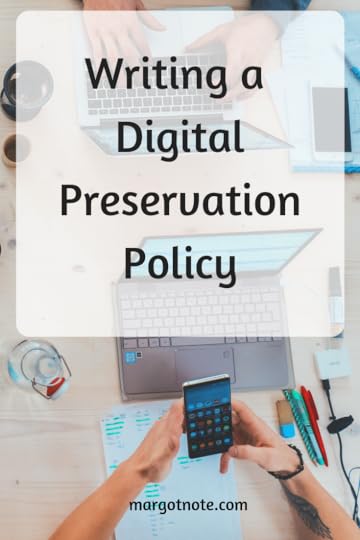
June 17, 2019
Archives, Library, and Museum Leadership: Collaboration and Coalescence
I want to raise the profile of archivists and ensure that they are supported by their organizations and by an informed public that appreciates the value of their service. The vitality and growth of the field depends upon positioning professionals to be confident voices in a dynamic information environment.
Transformative change and advocacy can sometimes be a challenge because most cultural institutions value tradition more than innovation, but archivists must creatively respond to complex organizational and field-based issues. Archivists should cultivate skills to help them become better advocates for themselves, their repositories, and the profession as a whole.
One fundamental way to do this is to assist archives, library, and museum professionals to create cross-sector collaborations for our common benefit. At a time of dwindling financial support, cultural institutions will thrive only if they can prove that they provide unique, essential, and compelling value in the public’s eye. Levering resources by collaboration across institutions can achieve this, as well as delivering services that are organized around user needs and not professional sensibilities and silos.
While libraries, archives, and museums have taken separate routes to professionalization, the digital environment and its many opportunities for collaboration are unifying cultural institutions. Most users of heritage content seek quick and easy access to information on their research interests without much regard to source. In the networked environment, many potential patrons may bypass cultural heritage institutions for the less authoritative, but more comprehensive experience online offered by companies like Google and Amazon. Libraries, archives, and museums will have to provide competitive services.
The Internet is changing the way users approach archival research and their expectations. They have come to expect that cultural heritage content will be available digitally. They also assume they will be able to interact with their content and obtain research help virtually. The integration of the fields will become essential in maintaining relevance in an information landscape dominated by corporations. This competition will compel the information fields to think dynamically and creatively. We are up for the challenge.
At the same time, professional communities in the cultural heritage sector should work together in ways that do not compromise their necessary independence. Libraries, archives, and museums will continue to maintain their own cultures, traditions, and viewpoints, while finding the way forward together. The essence of their character will not be diluted through collaboration, but fortified through coalescence on specific pursuits.
I’ve noticed that the projects I’m most drawn to were ones that united the strengths of each information sector field. In my experience, I’ve looked to museums for ways to tell stories better with archival holdings and to strategize on outreach activities. I’ve also called upon my library experience and education when performing reference interviews and offering information services to aid my colleagues and students in their research. In my writing, I’ve addressed an audience of professionals who work in some information capacity, regardless of education or professional background. My point of reference will always be at its essence archival, even as I borrow and implement the best practices of libraries and museums.
Leadership demands thinking bigger and being visionary about how projects can be planned and performed. When selecting and planning projects, for example, it is worth taking a moment to think about how the project could be transformed from delivering a suitable solution to being a project that catches the imagination of the public.
Leading in an era of change and complexity is both daunting and exciting. Archivists who are equipped to work with others, prepared to look critically at what they do, and assist the people whom they serve will be capable of leading their organizations forward into the future. Cultural heritage fields—especially archives—must be forward thinking while still preserving the past. To prolong the existence of cultural heritage is our goal and our reward.
How do you think that professionals working in archives, libraries, museums, and similar environments can demonstrate leadership?
If you like archives, memory, and legacy as much as I do, you might consider signing up for my email list. Every few weeks I send out a newsletter with new articles and exclusive content for readers. It’s basically my way of keeping in touch with you and letting you know what’s going on. Your information is protected and I never spam.
Follow me on Pinterest | Instagram | Twitter | LinkedIn | Facebook
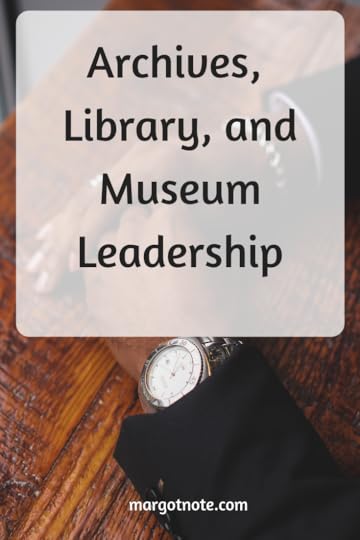
June 10, 2019
Choosing Which Digital Archives to Preserve
Appraisal and selection for digital artifacts are similar in the broadest sense to the appraisal and selection of physical archival collections. The framework that each institution uses to guide its selection process is influenced by the scope and subjects of the collecting agencies.
Technical AppraisalThe long-term preservation of digital material relies on the understanding of how file formats work. It requires access to appropriate software and hardware and the skills to use them. If these factors are unavailable in an archival institution, digital preservation will be unsuccessful. Therefore, technical appraisal that considers how digital files can be read, documented, processed, and preserved becomes instrumental.
Choosing Which Digital Archives to Preserve - Common Selection CriteriaThe factors that help with choosing which digital archives to preserve depend on the discipline, but some general criteria apply. First, the content should have relevance to the mission of the archival repository. One hopes that this is a given, but it’s important to note that the materials should support the organization's mission and strategy.
Historical values should be considered as well. Do the digital files have enduring value? Are they culturally or socially significant? Assessing value involves inferring anticipated future use based on current and educational values.
The reliability, integrity, and usability of the digital files need to be determined. Are the materials in preservation-friendly file formats? Are there limits to the materials (including intellectual property or privacy) that would make the files inaccessible for research?
Funding is an important factor to consider. Costs for managing and preserving the resource may be estimated, and are justifiable when assessed against evidence of potential future benefits. What is the likelihood that external funding can be secured to support the preservation of the materials?
Is the digital content unique? Consider the extent to which the resource is the only or most complete source of information that can be derived from it. Research whether it is at risk of loss if not accepted or may be preserved elsewhere.
Lastly, are the files fully documented? Do they contain information necessary to facilitate future discovery, access, and reuse? Is the information comprehensive and correct, including metadata on the materials’ provenance and the context of its creation and use?
Selecting Everything is UnwiseIn an era when the production of digital files is frenetic, and storage costs are considered cheap, some advocate for keeping everything, arguing that it is impossible to know if the information will be of value in the future. They also contend that that costs of keeping all digital files are less than the costs of selection.
Trained as a records manager, and as one who sees the costs and risks of keeping it all, I argue differently. The rate of growth continues to expand, which causes backing up files for digital preservation to double the number of materials. There are limited resources available for managing and preserving these materials, including the costs of creating metadata. Additionally, search mechanisms for accessing large collections are inadequate. The discovery of information gets harder, as we lack adequate, accurate tools for precise searching. Selection also curates quality collections that have high research value.
Selection Requires Human InterventionNo matter how sophisticated our digital systems become, high levels of human input are required when choosing which digital archives to preserve. While some decisions could become automated in some time in the future, we still need to balance the benefits of saving some digital materials over others. One thing is for sure: a discipline-specific selection framework and the experience of professionals guides the appraisal of digital archival materials. Archivists continue to rise to the challenges of selection to maintain digital artifacts in a changing technological landscape.
The blog was originally published on Lucidea's blog.
If you like archives, memory, and legacy as much as I do, you might consider signing up for my email list. Every few weeks I send out a newsletter with new articles and exclusive content for readers. It’s basically my way of keeping in touch with you and letting you know what’s going on. Your information is protected and I never spam.
Follow me on Pinterest | Instagram | Twitter | LinkedIn | Facebook
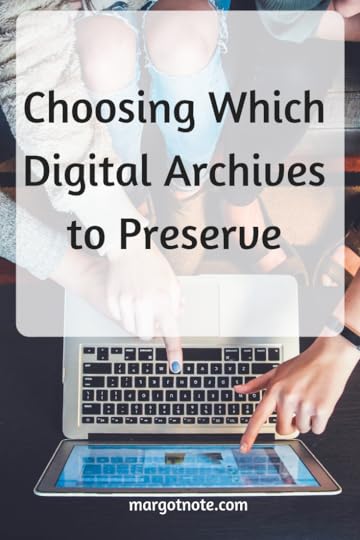
June 3, 2019
Digital Archives: Choosing Sustainable File Formats
The sustainability of digital materials depends on standard file formats that will last for the long term. As technology changes rapidly, archivists and other information professionals need to use a narrow set of sustainable file formats to retain information between systems and programs. As new formats develop, sustainability must become part of the design process from the beginning to make the efforts of digital preservation successful.
Cultural heritage institutions have led efforts to identify formats that are promising for long-term sustainability, and to develop strategies for sustaining these formats—including recommendations about the tools and documentation needed for their management.
Sustainability FactorsThe Library of Congress has developed some criteria for predicting sustainable file formats in digital archives. The first, of course, is adoption. The format should have widespread use. File formats should have a level of transparency, which allows files to be identified and their contents checked. Disclosure—whether the file format specifications are in the public domain—is also analyzed. Is the format an open standard, fully documented, partially documented, or have little documentation? Documentation of the standard and self-documentation through metadata support are essential too, as the latter should be provided within the format. File formats should also embody interoperability, functioning within a variety of services; they should be independent of external hardware or software. Lastly, the format should be “open,” because digital rights protections, licensing, patents, and intellectual property issues complicate preservation.
File Format AssessmentsThe British Library, the Library of Congress, Harvard Library, the National Archives and Records Administration (NARA), and the Digital Preservation Coalition (DPC) analyzed commonly-used file formats. The organizations wished to document gaps in current best practice, understanding, and capability in working with specific file formats. Their file format assessment is available on the DPC website (here). These organizations have identified ways in which format creators can produce more evergreen formats.
Some Definitive ConclusionsSome file formats have become preferred, such as the use of TIFF (Tagged Image File Format) to create preservation master images for many digitization programs. TIFFs are flexible, stable, and widely used. More than likely, this file format will continue to be the standard in the long term.
In a similar vein, PDF/A, a variant of PDF, is a standard file format for documents. PDF was originally a proprietary file format but became an open standard. PDF reproduces the visual appearance of digital materials, like a Word document. The PDF/A format adds a layer of preservation by being self-contained. All the information needed to display a document must be present in the file and cannot refer to external sources such as fonts. The PDF/A standard also mandates the use of metadata to specified standards.
Others Still in FluxOther file format standards are still being agreed upon, especially with formats used for complex digital objects like video. The previously used formats for video were lossless Motion JPEG 2000 and uncompressed video.
Currently, for video files, some archivists prefer uncompressed V210 Video Picture Encoding/linear pulse-code modulation (LPCM) in a MOV wrapper. V210 digital, color-difference component video picture format and LPCM is a standard format used for digital audio applications. Others prefer open-source FFv1/LPCM in a Matroska Multimedia Container (MKV) wrapper. FF video codec 1 or FFV1 is a lossless intra-frame video code. The MKV is an open-standard format that can hold an unlimited number of video, audio, picture, or subtitle tracks in one file. No consensus to date exists among the archival community as to which file format or codecs should be used for preservation purposes for digital video. As an archivist with limited experience in preserving digital video, I look forward to more definitive agreements in this area.
Evolving Digital Sustainable File FormatsNo matter your preservation actions—migration to new formats, emulation of current software on future computers, or a hybrid approach—sustainable file formats are crucial. Articulating our needs, analyzing our options, and agreeing upon formats helps preserve digital files as authentic, reliable resources for future generations. Lasting file formats influence the feasibility of protecting content in the face of changes to the technological environment in which users and repositories operate.
The blog was originally published on Lucidea's blog.
If you like archives, memory, and legacy as much as I do, you might consider signing up for my email list. Every few weeks I send out a newsletter with new articles and exclusive content for readers. It’s basically my way of keeping in touch with you and letting you know what’s going on. Your information is protected and I never spam.
Follow me on Pinterest | Instagram | Twitter | LinkedIn | Facebook

May 27, 2019
Expanding Digital Preservation Collaboration
While digital preservation efforts are being led by members of the cultural heritage community working at institutions traditionally responsible for saving materials, the challenges of digital preservation require the involvement of new participants.
New StakeholdersNew stakeholders include many organizations with diverse needs and priorities, including government agencies, media companies with digital content catalogs, community groups documenting their histories, and companies needing to maintain records for business use and pending or anticipated litigation. Other stakeholders include individuals, rights holders, funding agencies, users, hardware and software developers, producers, and distributors of digital materials.
Collaboration and CooperationCollaboration with these stakeholders is required to make digital preservation activities effective. Cooperation with communities beyond archives, libraries, and museums may increase funding opportunities, build shared resources, and eliminate redundancies. An interdisciplinary approach is needed because discovering new preservation frameworks assists everyone, no matter what the materials, or industries that employ them. Outdated boundaries, even among library, archive, and museum knowledge workers, no longer serve us when faced with the complexity of digital preservation activities.
The higher stakes in digital preservation are creating a stimulus for new stakeholders to emerge and add value. Digital materials also require creators to act as the “first responders” to preservation. The extent and nature of collaborative activity have been noted in efforts such as the “Community Watch and Participation” action of the Digital Curation Centre’s Curation Lifecycle Model, where collaboration to develop shared standards, tools, and software is promoted. Archivists cannot preserve everything alone.
Big Data ScholarshipOne of the principal participators and drivers of change is scholars, most notably those in the sciences but also in the social sciences and the humanities. Scientists increasingly use data-driven techniques and generate and re-use large data sets; increasing attention is being paid to the long-term preservation of scientific data.
The dissemination of scholarly output and its maintenance over time is another factor to consider. Open access journals, standards for interoperability aimed at making data open, and interest in making research data available have all created opportunities to seek preservation solutions.
PublishersBook and journal publishers are another stakeholder group impacted by the shift to born-digital content. Scholars publish in journals to preserve their work and make it available for current and future researchers. Academic libraries, which have traditionally overseen the preservation of print publications, are now struggling with the preservation of digital scholarly works because of technical and licensing constraints and economic concerns.
Additionally, creators of electronic resources are now able to bypass the traditional publication, dissemination, and announcement processes of the print environment. Publishers and librarians who managed this process now look to technologists and computer scientists to develop systems that support these activities. Best practices and policies that satisfy both the requirements of the digital environment and the economic interests of stakeholder groups are needed.
Many academic libraries have subscription-based digital resources that are primarily managed by agreement with the publisher or vendor to use third-party preservation services (such as Portico and LOCKSS). Portico is a community-supported digital archives that works with libraries and publishers to preserve e-journals, e-books, and other electronic scholarly content. Stanford University Library’s LOCKSS (Lots of Copies Keep Stuff Safe) project has developed an infrastructure for keeping materials preserved and accessible.
Audiovisual ArchivesStakeholders interested in preserving video is another group of active stakeholders. For instance, the organization WITNESS trains activists to preserve their video documenting human rights abuses. Their Activists’ Guide to Archiving Video, written in English, Arabic, Spanish, and Portuguese, provides best practices for organizing, storing, preserving, and sharing footage.
As police departments increasingly use body cameras, new stakeholders are engaged in preserving audiovisual evidence. Law enforcement agencies, technology vendors, advocacy groups, and audiovisual archivists are working together to address the preservation of large volumes of video data over a long period.
Sharing and Consultation with StakeholdersAs the field of digital preservation grows, it is essential to gain buy-in from new stakeholder groups to ensure policies and strategies are both fit for purpose and will have support. Bringing preservation concerns outside of the traditional realm of archives and libraries is a crucial step in advocacy. A broader engagement with stakeholders from various backgrounds allows everyone to understand how digital preservation activities relate their work and interests.
The blog was originally published on Lucidea's blog.
If you like archives, memory, and legacy as much as I do, you might consider signing up for my email list. Every few weeks I send out a newsletter with new articles and exclusive content for readers. It’s basically my way of keeping in touch with you and letting you know what’s going on. Your information is protected and I never spam.
Follow me on Pinterest | Instagram | Twitter | LinkedIn | Facebook
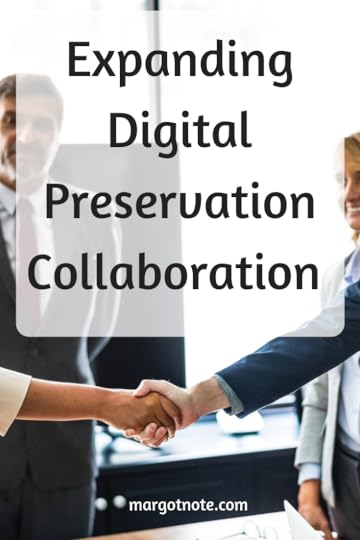
May 20, 2019
Preserve, Curate, or Steward? Changing Definitions in Digital Preservation
Digital preservation is a series of managed activities necessary to ensure continued access to digital materials for the highest utility—and for as long as possible or necessary. Archivists work to save bits and bytes beyond the limits of media failure, software obsolescence, and technological change. The phrase “digital preservation,” however, has been questioned because it may not sufficiently describe what needs to occur for digital materials to be accessible over time.
Preservation is Only the BeginningPreservation rose from the idea that saving existing digital information was the first and most important part of this effort. Preservation, however, is just one aspect, albeit an important one, of what these activities encompass. Considering all the actions that archivists must conduct to protect digital materials throughout their lifecycle, is “preservation” the most accurate description? As the idea of preservation in the digital environment is challenged, other definitions that are perhaps more definite have emerged.
More Precise ConceptsThroughout the literature, practitioners have introduced and explored the concepts of digital continuity, digital sustainability, and digital resilience. Each definition has its nuances, but they all share a unifier. They reflect a shift in thinking of preservation as a one-time activity (as was applied to physical artifacts) to preservation as an ongoing approach. This change in thinking reflects the acceptance that the preservation of digital artifacts ideally starts when they are created and continues throughout their life.
In addition, preservation has a long history of being used within a cultural heritage context, but not regularly used outside of it. While digital preservation affects all research communities—academic, cultural, social, technological, and scientific—the phrases each group uses to describe similar activities will reflect their priorities.
Digital curation and digital stewardship are terms that have also gained traction within the professional literature. These terms refer to the lifecycle of a digital file, from the creation, collection, organization, and dissemination of digital objects.
Digital CurationCuration concepts have arisen from the scientific communities, who are motivated more by the practical, immediate data re-use concerns than by theoretical preservation concepts. “Curation” describes the evolving whole-life view of digital preservation but concentrates on the underpinning activities of building and managing collections of digital assets. Curation also implies expertise in one narrow area, rather than a generalist approach. The concept of “content curation” which aggregates, organizes, and filters online resources in subject areas has become more widely known. “Curation” has also become more popular as a marketing term, which tends to dilute its importance.
Digital StewardshipStewardship models evolved out of the environmental community. Stewardship denotes the idea of holding resources in trust for future generations, which has long resonated with digital preservation practitioners.
Stewardship, unlike curation, implies that it is a role for a generalist: someone who is knowledgeable in sustainable digital file formats, practical and useful applications of standards, quality control, and other aspects of digital preservation. The knowledge necessary to save digital materials is continually evolving, requiring archivists to be knowledgeable on a range of topics. Digital stewards can work with subject matter experts like curators to leverage their expertise for digital preservation projects.
The National Digital Stewardship AllianceStewardship, in this context, is best embodied in the National Digital Stewardship Alliance (NDSA), an organization that incorporates a unified vision of digital preservation while leveraging community collaboration to ensure enduring access to digital information. NDSA created the Levels of Digital Preservation, a tiered set of recommendations on how organizations should begin to build their digital preservation programs. The easy-to-use guidelines, along with NDSA’s other activities, integrate the perspective of experts and institutions to provide insight into emerging technological trends and critical areas for development.
Reshaping Preservation PracticeDigital stewardship marries preservation and curation, unifying the lifecycle approach of curation along with research in digital libraries and electronic records archiving. Stewardship broadens the emphasis to address all digital materials, while continuing to underscore digital preservation as a core component of action. Stewardship embodies both the essential elements of the archives profession as well as the custodial dimension of the curatorial profession.
The blog was originally published on Lucidea's blog.
If you like archives, memory, and legacy as much as I do, you might consider signing up for my email list. Every few weeks I send out a newsletter with new articles and exclusive content for readers. It’s basically my way of keeping in touch with you and letting you know what’s going on. Your information is protected and I never spam.
Follow me on Pinterest | Instagram | Twitter | LinkedIn | Facebook
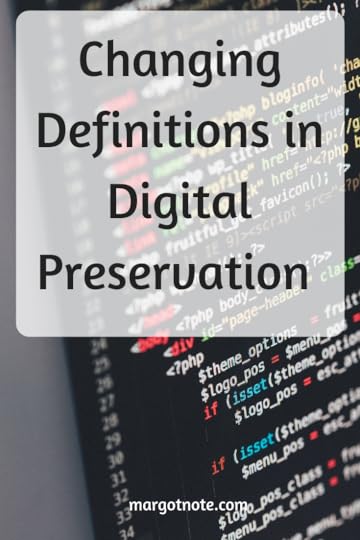
May 13, 2019
Donating Your Family Archives
If you are the keeper of family history items that you believe could be of interest to scholars, you may wish to donate them to an institution where they will be archived and available for others to use.
The Society of American Archivists (SAA) provides an excellent Web site with general information about collections and donations. Look specifically for the SAA publication “A Guide to Donating Your Personal or Family Papers to a Repository.”
More and more archives, libraries, and museums are reaching out to families with encouragement to donate. They recognize that we are the source and subjects of social history.
Donation ConsiderationsHere’s some tips to consider before you donate:
Most repositories use professional standards, trained archivists and conservators, and archival supplies and environments. Ask whether they do. They can provide a safer home for our documents than we can.
If you are unsure of the most appropriate repositories in your area, reach out to your state historical society for recommendations.
Many archivists would rather you not organize, sort, or discard your materials before you contact them. They will do the cataloging themselves.
A repository may accept anywhere from a single item to an extensive collection if they deem it relevant and worthy of preservation.
Most archives will ask you to transfer ownership to them as well as copyright of the collection. You can request to retain copyright for a period, but researchers will be reaching out to you to seek your permission to publish anything from your collection. The inconvenience for them and you is a good reason to transfer copyright. Make sure that the copyright is yours to transfer. It first belongs to the creators of the documents and their heirs.
Repositories will ask you to sign a deed of gift to keep the agreement unambiguous and legal. Most public archives can't spend their resources to maintain you collect for you, so they want to “own” it for public access to justify their investment of resources. Again, the repository may seek evidence from you that you truly own and have the rights to donate the collection.
Archivists prefer that you allow unrestricted access to your collections, but if there is a reason to keep something private you may arrange such specifications for a period. Don't self-censor your records; discuss with the archivists about limiting access to sensitive materials.
If your documents are recent enough that privacy laws may apply, consult with the archivists whether there is private information about anyone they need, by law, to protect. Such documents might include medical, school, tax, or legal records.
As they process the collection, the repository staff will make decisions about whether to discard some items as valueless. You can state in advance what you want them to do with the discards, including that they might return them to you.
You may wish to determine a monetary value of your collection so you can take a charitable tax donation. Seek tax experts or attorneys for advice. You may need to hire a personal property appraiser. The Internal Revenue Service requires an independent appraisal if you value the donation above a certain amount. The archives cannot provide this service but may keep a list of appraisers. For tax purposes, make sure you get receipts.
You may also wish to offer a monetary donation to the repository to help support the care of the collection.
Be kind to archivists. Many institutions are understaffed, and archival staff members wear many hats.
To learn the preservation secrets used by libraries, archives, and museums to protect their priceless materials (that you can also use for your family heritage items) read my book:
Creating Family Archives: How to Preserve Your Papers and Photographs
By Margot Note
Ready to get started creating your family archives? Here are some of my favorite products:
Follow me on Pinterest | Instagram | Twitter | LinkedIn | Facebook
Like this post? Never miss an update when you sign up for my newsletter. As a gift to you, you'll receive a free, premium download of my Project Prioritizer. This trusted tool will help you embrace where you are with your collections and start enjoying your family archives more today.
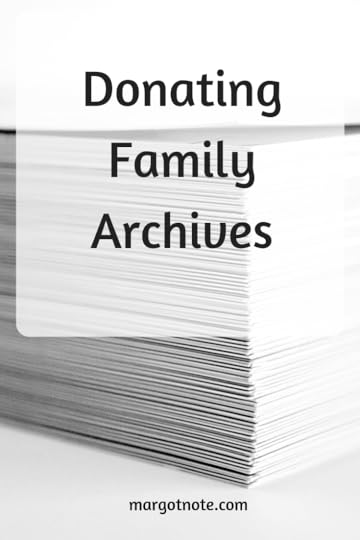
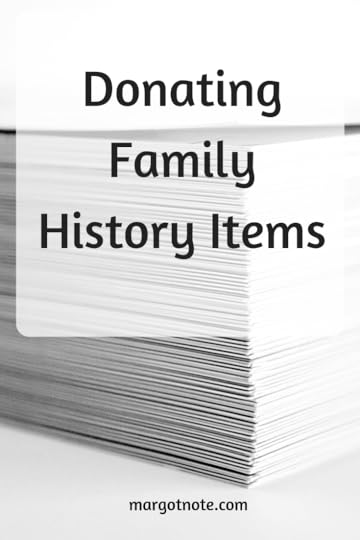
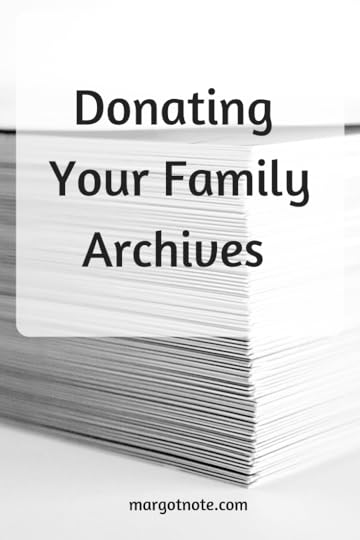
May 6, 2019
Hiring a Photo Editor and Researcher
Photo editing and research are time-consuming and detail-oriented. The work requires multiple emails per image as permissions, fees, and usage are negotiated. Captions and credits are unique to each image and must be tracked as well. Take the number of images you’d like for a project and imagine the number of interactions you’d need to secure usage. It adds up quickly. Authors are interested in getting the content of their projects correct. They don’t need the added complexity of securing image permissions.
Why Hire a Photo Editor and Researcher?Photo editors know the sizes, resolutions, and orientations that will work the best for your project. They know how to find the best pictures fast for the best prices. They often already have connections to image repositories and relationships with vendors that can offer them considerable discounts. They have also worked on both print and online projects and know where image needs can differ depending on the project.
Quick TipsHere's some knowledge I've gained from working on image management and photo editing projects over the years:
Know the budget. If the photo editor knows how much money to spend, she’ll be able to prioritize what to focus on and what to purchase.
Sometimes buying an image outright is less expensive in the long run than spending time looking for a free or low cost option.
Most photo projects follow the 80/20 rule. Eighty percent of the images are easy to retrieve, but they require time for research and paperwork. Twenty percent are complicated, requiring more effort and lots of back and forth to get the image. The complexity rises if a specific image is required, rather than when you have similar options to choose from.
Image banks are usually not a solution. Most stock photography lacks personality or is expensive, or both. Getty Images, for example, offer superb images, but the prices and usage limitations are outrageous; a single photograph costs over $500. Over time, I’ve developed relationships with some overlooked image banks that offer unique photographic takes and affordable prices.
Look to museums and archives. Using images from heritage institutions highlights treasures from their collections, promotes them, and supports their work through usage fees. The project gains access to amazing visuals and nonprofit organizations benefit.
Hire an ExpertFor your next project, invest in a photo editor who can get the best images for the best values. Contact me to begin a conversation about your photo editing and research needs.
Contact
If you like archives, memory, and legacy as much as I do, you might consider signing up for my email list. Every few weeks I send out a newsletter with new articles and exclusive content for readers. It’s basically my way of keeping in touch with you and letting you know what’s going on. Your information is protected and I never spam.
Follow me on Pinterest | Instagram | Twitter | LinkedIn | Facebook
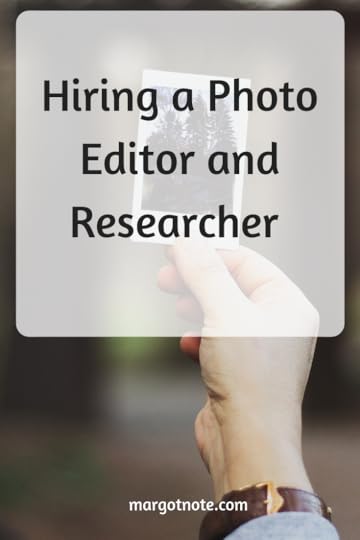
April 29, 2019
10 Ways Consultants Transform Organizations
As a Certified Archivist, a Certified Records Manager, and an Information Governance Professional, I help my clients to benefit from their information, from its creation, use, storage, and disposition. Working with a skilled consultant gives you peace of mind that your data is always ready to be leveraged throughout its life cycle.
The Alchemy of AdroitnessNo matter how big or small your project is, an archives and records management consultant can help you transform your organization through its information. Here are ten ways in which consultants work magic:
Expertise. The skills necessary for the growing and changing needs of an organization are unavailable inside the organization. Therefore organizations turn to consultants to complete projects or solve problems.
Time. Even when the skills are available in the organization, staff members may not have the time to complete special projects or research. A consultant can be a part of the organization just long enough to achieve what needs to be done.
Experience. Certain professions have a shortage of trained employees. Consultants can fill in until demand is met by training or hiring new employees.
Flexibility. Consultants can be brought in for the short term to complete a project. When the work is completed, the organization can terminate the relationship easily and quickly.
Objectivity. Consultants provide fresh perspectives. Outsiders can look at a problem in a new, unbiased way.
New Ideas. Consultants bring with them ideas from other businesses and fields. The cross-pollination is a sure-fire way to tape into many resources. Staff members may be too close to the problem to see a new solution.
Efficiency. Hiring a consultant who has experienced the same type of project in the past may be faster and more cost-effective than bringing staff members up to speed.
Assessment. A consultant can provide an objective evaluation, define the problem, and make recommendations.
Resolution. In the case of a change in organizational structure, a consultant can act as an independent mediator to solve problems.
Compliance. An organization may not have enough time and may lack the expertise to comply with legal expectations. Hiring a consultant shows that an effort is being made to correct the problem.
Leverage ExpertiseInterested in learning more? Contact me to begin a conversation about your archives and records management needs.
Contact
If you like archives, memory, and legacy as much as I do, you might consider signing up for my email list. Every few weeks I send out a newsletter with new articles and exclusive content for readers. It’s basically my way of keeping in touch with you and letting you know what’s going on. Your information is protected and I never spam.
Follow me on Pinterest | Instagram | Twitter | LinkedIn | Facebook
